
With rising food prices and ongoing inflation, many households are rethinking how and where they spend their money on meals. Dining out may be convenient, but it can quietly drain a substantial portion of your annual budget. By contrast, cooking at home, especially when using thoughtful meal planning, versatile ingredients, and flavorful spice blends, offers a more affordable, nutritious, and rewarding alternative.
At The Spice & Tea Shoppe, we’ve always believed that your spice cabinet can be the most powerful tool in your kitchen. With just a few carefully chosen blends, you can cook dozens of unique dishes, reduce waste, and bring global cuisine into your home without breaking your grocery budget.
This guide explores the true cost of dining out in 2025, how to make the most of your time and budget in the kitchen, and how spices can transform simple ingredients into memorable meals.
Dining Out in 2025: A Growing Expense
Dining out continues to grow more expensive year after year. In 2021, the average American spent over $3,000 per year on food prepared away from home. As of early 2025, that number has risen to approximately $3,800 to $4,200 annually, depending on location and frequency of dining out. For those who enjoy a daily or near-daily coffee shop visit, say five $6 drinks per week, that’s another $1,560 per year just on coffee.
Combined, that's over $5,700 per person spent annually on food and beverages outside the home. For a family of four, that could easily exceed $20,000, nearly equivalent to the cost of a small vehicle or multiple months of rent or mortgage payments.
These numbers don’t reflect other hidden costs such as tipping, delivery fees, or transportation. While dining out can be enjoyable, it’s become a financial burden for many households looking to save or reprioritize their spending.
What Does a Home-Cooked Meal Cost?
On average, preparing meals at home costs about $4 per serving, a stark contrast to the typical $13 restaurant entrée. That’s a 325% increase when eating out compared to home cooking.
The cost savings become even more apparent when you consider meal planning, using leftovers, and buying ingredients that can be repurposed for multiple dishes. Cooking at home also allows you to adjust portion sizes, choose healthier ingredients, and better manage dietary preferences.
Initial investments in pantry staples such as olive oil, rice, pasta, legumes, and a variety of spices can seem like a higher upfront cost, but they’re long-lasting and serve as the foundation for dozens of affordable meals.
Spices: The Secret to Affordable Variety
One of the biggest advantages of home cooking is flexibility. However, many people worry about flavor fatigue when preparing similar ingredients week after week. That’s where spices come in not only for variety but for affordability.
A single high-quality spice blend can flavor 8 to 20 meals, depending on the recipe and amount used. Here’s how:
Global Variety A blend like our North African Harissa can bring bold heat and depth to soups, roasted vegetables, grains, or grilled meats.
Weeknight Flexibility Use Italian Seasoning or Taste of Tuscany for pasta sauces, sautéed vegetables, and baked chicken, all with completely different flavor profiles.
Customizable Dishes Mix and match blends to create new versions of the same base recipe. Chili, rice bowls, soups, and stir-fries can take on endless variations.
Spices don't just enhance flavor. They reduce your reliance on sauces, expensive marinades, and pre-seasoned items that come with a premium price tag. With a well-stocked spice cabinet, even simple rice and beans can taste entirely different every night of the week.
Batch Cooking and Meal Planning: Practical and Time-Saving
Batch cooking, or preparing meals in large quantities to be eaten throughout the week or frozen for later use, is one of the most effective strategies for saving money and time.
Start by selecting versatile base recipes such as soups, stews, rice and grain bowls, pasta sauces, and casseroles that reheat well and can easily be varied with different toppings or sides. Add spice blends like Madras Curry, Chili Seasoning, or Hamburger and Meatloaf Seasoning to transform the same ingredients into multiple dishes.
Benefits include:
-
Lower per-serving cost
-
Less food waste
-
Fewer takeout temptations
-
Time saved during busy workweeks
Planning for two or three large meals per week that yield leftovers allows you to enjoy homemade lunches and dinners without daily prep.
Smart Ingredient Swaps to Stretch Your Budget
Mushrooms as a Meat Alternative
Mushrooms have a naturally umami-rich, meaty texture, making them an ideal substitute for meat in stews, stir-fries, tacos, and sandwiches. Portobello, shiitake, and brown button mushrooms hold up well to heat and can absorb spices beautifully.
Try grilling or roasting with Herbes de Provence or Chipotle Honey and Citrus Rub, then serve in grain bowls or wraps.
Mushroom Pâté Tip Sauté mushrooms and shallots in butter and olive oil, blend with soaked walnuts, and season with Savory Garlic and Herb for a flavorful spread.
TVP – Textured Vegetable Protein
TVP is shelf-stable, affordable, and protein-packed. It takes on the flavor of whatever spices or sauces you add. Use it in chili, spaghetti sauce, tacos, or sloppy joes.
Legumes and Whole Grains
-
Dried Beans Soak and cook in large batches to use in soups, salads, and grain bowls.
-
Lentils Fast-cooking and ideal for curries, stews, or burgers.
-
Brown Rice, Barley, Quinoa Inexpensive staples that pair with any seasoning.
Spice blends like Za’atar, Ras El Hanout, or curry blends bring out the best in these pantry ingredients.
Frozen and Fresh Vegetables
Frozen vegetables are often just as nutritious as fresh and are more convenient. You can buy in bulk and use only what you need, minimizing waste.
Pro tip Blanch fresh produce and freeze in portioned bags to extend shelf life. Add spice blends directly to vegetables before roasting, steaming, or sautéing.
Examples:
-
Frozen Broccoli and Garlic Herb Blend
-
Corn and Peppers and Cajun Blackening Rub
-
Green Beans and Lemon Dill Seasoning
Vegetable Stock: The Ultimate Use for Scraps
Vegetable scraps often go straight to the trash or compost. But onion skins, celery ends, herb stems, mushroom stalks, and carrot tops can be frozen in a bag until you have enough to make homemade stock.
Simmer with bay leaves, garlic, and your favorite all-purpose seasoning like Bouquet Garni "French Soup Herbs" for a flavorful broth. It’s cost-effective, low in sodium, and full of body, perfect for soups, risottos, or braising.
Make the Most of Leftover Bread
Stale bread is a versatile ingredient that can be repurposed in many delicious ways.
Croutons
Cube and toss with olive oil and spice blends like Pizza Blend, Italian Herb, or Tuscan Garden, then bake until golden. Use in salads, soups, or as a crunchy topping.
Breadcrumbs
Pulse dried bread in a blender with seasonings to use as a coating or binder. Mix with lentils or grated vegetables to make budget-friendly meatballs and loaf recipes.
Sweet and Savory Dishes
Day-old bread can be transformed into:
-
Savory strata with cheese and vegetables
-
Overnight French toast
-
Bread pudding (sweet or savory)
-
French onion soup topping
-
Churro-style air fryer sticks with cinnamon sugar
Reduce Waste with Creative Planning
Beyond batch cooking, food preservation helps lower your grocery bill:
-
Freeze leftover tomato paste, pesto, or sauces in ice cube trays.
-
Save extra herbs by drying or freezing in oil.
-
Turn aging produce into soups, stir-fries, or pickles.
When using spice blends, keep in mind that a little goes a long way. A single jar of seasoning like our Jamaican Jerk Seasoning or Lemon Pepper can flavor dozens of meals across proteins, vegetables, rice, and grains.
Building a Flavor-Forward Pantry
A well-stocked pantry doesn’t need to be extensive, just thoughtful. Here’s a starter list of affordable staples that, combined with five to ten spice blends, can yield weeks of diverse meals:
Pantry Basics:
-
Dried beans, lentils, rice, quinoa, pasta
-
Canned tomatoes, canned pumpkin, coconut milk
-
Olive oil, vinegar, flour, salt, pepper
-
Onions, garlic, potatoes
-
Frozen or fresh seasonal vegetables
Spice Blends to Keep on Hand:
-
Italian Seasoning Blend For sauces, soups, and roasting
-
Yellow Indian Curry Ideal for lentils, vegetables, and rice
-
Taco Seasoning - Fajita Seasoning for beans, ground meat or TVP, rice
-
Chili Seasoning Great for one-pot meals and stews
-
Za'atar Mix or Ras el Hanout To explore Middle Eastern and North African dishes
-
Sweet spices like cinnamon, nutmeg, and ginger for desserts or oatmeal
Final Thoughts: Eating Well Without Spending More
Eating at home not only stretches your food budget, it puts you in control of nutrition, flavor, and variety. By incorporating versatile, affordable ingredients and using spices strategically, you can craft meals that rival restaurant quality for a fraction of the price.
With The Spice & Tea Shoppe’s curated collection of handcrafted spice blends, gourmet pantry items, and premium teas, your home kitchen can become your favorite place to create meals that reflect your taste, values, and budget.
Ready to Start Saving and Cooking More at Home?
Browse our online store or visit us in person to discover spice blends and pantry essentials that make cooking at home both practical and enjoyable.
Let's Get Cooking
For more culinary inspiration, be sure to visit our recipe page. Here, you'll find a diverse collection of delicious recipes for every taste, season and occasion.

